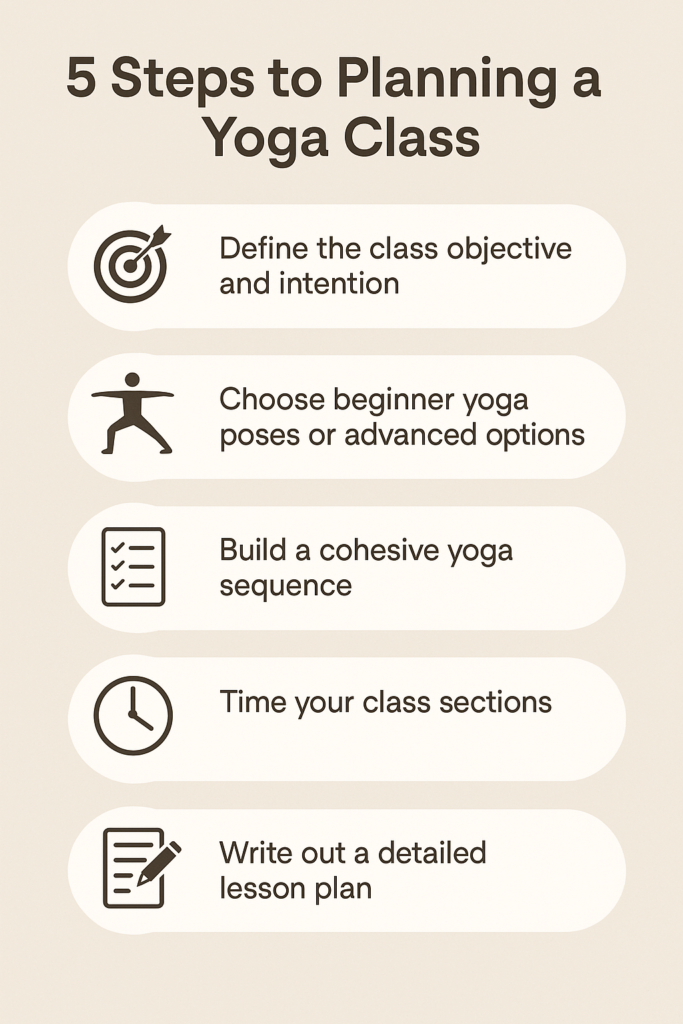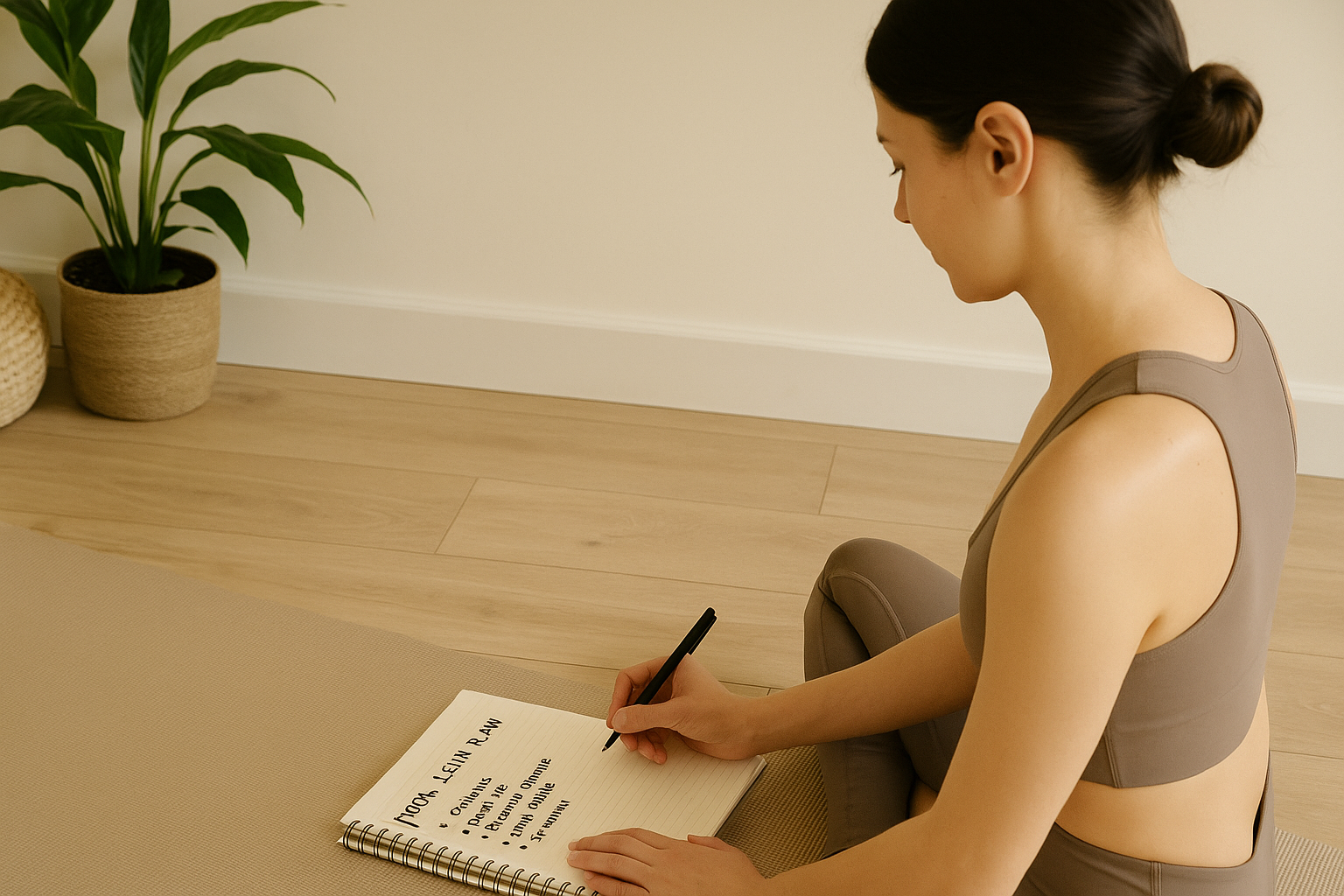Crafting a truly engaging yoga class takes more than just sequencing poses—it requires thoughtful planning, intention, and a clear understanding of your students’ needs. Whether you’re a new instructor or looking to refine your teaching process, this complete guide will walk you step by step through creating classes that foster growth, connection, and confidence in every student. Let’s explore the art and science of successful yoga class planning together!
Why Step-by-Step Planning Matters for a Successful Yoga Class
As a yoga teacher, creating effective sessions comes down to more than intuition—consistent step-by-step planning is the cornerstone of every successful class. When you thoughtfully plan your yoga lessons, you set the stage for engaging, purposeful experiences. Clear lesson planning ensures your students receive maximum benefit, while keeping you confident and adaptable throughout teaching. A well-developed class plan helps make each session flow, supports your growth as a teacher, and allows for creative, inspiring moments.
What Makes a Well-Structured Yoga Lesson Plan?
A well-structured yoga lesson plan forms the reliable backbone for every instructor’s teaching journey. When you plan yoga classes, you bridge the gap between a student’s needs and your vision as a teacher. Effective lesson planning isn’t about rigidly following rules—it’s about mapping out your class with intention, adaptability, and care. Leaning into smart class plans enables teachers to sequence asana, breathwork, and meditation in a way that builds energy and supports learning. As you plan, clarity on themes, poses, and timing creates a roadmap that keeps you grounded and lets your creativity shine through every lesson.
In your day-to-day planning, make space for not just structure but also flexibility. Thorough planning allows you to respond to real-time class energy, ensuring your lesson meets your students where they are. When you use a dedicated lesson planner, you’ll find that lesson logistics—like warm-ups, peak poses, and cool-downs—fall into place naturally. For new and seasoned teachers alike, returning to the basics of planning yoga ensures every class, from small workshops to large studio classes, is intentional, effective, and deeply rewarding. If you want to elevate both your students’ experience and your own sense of confidence while teaching, keep honing your plans—because each well-crafted lesson is a chance to help students unlock their potential.
How to Plan Your Yoga Class: A Step-by-Step Overview
From setting your class objective and intention to writing out a detailed sequence, every stage serves both your teaching craft and your students’ growth.

Step 1: Define the Class Objective and Intention
Before choosing a single pose, define your class objective and intention. This foundational step anchors the entire experience in purpose, guiding everything from your cueing to your energy. Without a clear objective, a class can feel disjointed or overly generic. With one, every posture and transition becomes more meaningful.
Start by identifying your students’ current needs:
- Are they beginners needing a slower pace?
- Is the group seeking strength-building or deep relaxation?
- Do you sense emotional tension that could benefit from grounding postures?
Next, select a central intention that supports those needs. This could be thematic (e.g., building resilience, opening the heart), energetic (e.g., calming the nervous system, invigorating the body), or seasonal (e.g., grounding in winter, expanding in spring). The intention doesn’t have to be spoken, but it should inform your choices.
For example:
- A class for anxious beginners might center around breath and stability, using long holds in standing poses.
- An intention to energize could include dynamic sequences, backbends, and quicker pacing.
- A class themed around letting go might emphasize hip openers and exhalation-focused breathing.
As you shape your lesson, continually return to this intention. It should influence pose selection, timing, and the tone of your verbal cues. A well-chosen objective keeps your teaching focused and makes the experience more transformative for students.
Step 2: Choose Beginner Yoga Poses or Advanced Options
Choosing the right postures for your students’ level is crucial to building both confidence and safety. Whether planning for beginners or advanced practitioners, the key is alignment with their physical ability, experience, and goals. Avoid assuming students will “figure it out.” Instead, meet them exactly where they are and support them from that point forward.
When working with newer students, prioritize beginner yoga poses that emphasize foundational alignment, balance, and breath awareness. Examples include:
- Mountain Pose (Tadasana): Reinforces posture and presence.
- Cat-Cow (Marjaryasana-Bitilasana): Warms up the spine and introduces breath movement coordination.
- Child’s Pose (Balasana): Offers rest while reinforcing safety and body awareness.
- Low Lunge (Anjaneyasana): Opens hips while keeping the knees supported.
- Bridge Pose (Setu Bandhasana): Strengthens the back body with minimal risk.
If your class includes a mix of skill levels, offer pose variations. Provide clear options for progressing or simplifying. For instance, in Warrior II, advanced students might add arm binds or extended holds, while beginners focus on alignment and breath.
Step 3: Build a Cohesive Yoga Sequence
Now it’s time to weave your selected asana into a cohesive yoga sequence that flows and supports your class intention. Yoga sequencing isn’t just about stringing poses together; it’s the art of transitioning consciously from one movement to the next, maintaining energy and safety for your students throughout class. Start by outlining the broad structure: warm-up, core practice, peak pose, and cool-down. This provides clarity for both teachers and students, making it easy to track progress and energy shifts.
As you sequence each section, focus on how the poses support one another and the class’s larger purpose. Do your transitions allow for graceful movement? Are there logical connections between each asana? Remember to account for the rhythm of your yoga class—alternate between strengthening and stretching, active and restorative moments. Good yoga sequencing builds anticipation for students while honoring the teacher’s overall plan.
To ensure flow, run through the sequence physically before class. Notice any points that feel awkward or disrupt the energy. Use your lesson planner meticulously—not just as a space for individual asana, but as a roadmap for the class’s emotional and physical journey.
Step 4: Time Your Class Sections
Structuring your class with precise timing ensures balance, flow, and a complete experience for students. Without a clear time allocation, you risk rushing the final section or dwelling too long in warm-up, which can throw off the rhythm. Start with a 60-minute class template and divide it into functional segments that match your sequence and intention.
Here’s a reliable structure:
- Warm-Up & Breathwork (10–15 mins): Begin with seated or reclined poses, gentle spinal movements, and breath awareness.
- Standing & Strength-Building (15–20 mins): Move into dynamic flows or static holds like Warrior series, Chair Pose, or balancing postures.
- Peak Pose or Deeper Work (10–15 mins): Introduce your apex posture here—perhaps a backbend, arm balance, or deeper hip opener. Lead up to it with preparatory poses that address required muscle groups.
- Cool Down & Floor Work (10 mins): Guide students into seated stretches, supine twists, or gentle inversions. This eases physical intensity and begins calming the nervous system.
- Savasana (5–10 mins): End with full stillness. Allow time for the body and mind to absorb the practice.
Always leave buffer time. If transitions take longer or students need more breath, you’ll stay on track. Don’t rush Savasana—it anchors the whole experience.
Use a timer, mental checklist, or music track lengths to keep your segments aligned without sounding mechanical. Timing is your silent partner in delivering a thoughtful, complete yoga lesson.
Step 5: Write Out a Lesson Plan
A written yoga lesson plan acts as your map. It organizes every part of your class—from intention to execution—so you can teach with clarity, flexibility, and presence. Skipping this step often leads to mental scrambling, inconsistent pacing, or missed opportunities to support your students fully.
Begin by listing each section of your class. Under each, include:
- Verbal themes or affirmations
- Pose names (English and Sanskrit)
- Breath cues (e.g., “inhale arms up,” “exhale fold”)
- Transitions between poses
- Modifications and props needed
Tips for Creating a Balanced and Inspiring Yoga Lesson Plan
Bringing balance and inspiration to your yoga lesson planning is where the magic happens as a teacher. Beyond simply filling time, effective class plans blend asana, breathwork, and meditation into a sequence yoga experience tailored to your students’ needs and energy. By carefully crafting each aspect of your plan, you elevate your teaching from routine to transformational. Listening to your students and tuning into real-time class energy allows you to adapt on the fly, ensuring every yoga session is both grounded and dynamic. Let’s explore the essential ingredients for planning yoga classes that motivate, challenge, and restore—every single time.
Include a Mix of Asana, Breathwork, and Meditation
An effective yoga lesson isn’t built on asana alone. Integrating breathwork (pranayama) and meditation elevates the class from physical movement to holistic practice. These components support nervous system regulation, mental clarity, and emotional balance—essential outcomes for modern students.
Start your planning by identifying how breath and stillness will show up in your class:
At the beginning: Begin with breath awareness to draw attention inward. A simple 3-part breath (dirga pranayama) or box breathing practice grounds the body before movement.
During transitions: Remind students to return to their breath as they move. Cue breath to initiate transitions (e.g., “inhale to rise,” “exhale to fold”).
After peak postures: Insert short holds in Child’s Pose or Downward Dog, encouraging breath recovery and reflection.
In closing: End with guided meditation, silent reflection, or visualization. Practices like body scanning, mantra repetition, or observing the breath in stillness create a deeper sense of integration.
Adapt Your Plan Based on Real-Time Class Energy
Even the most detailed lesson plan must remain flexible. Class energy can shift based on time of day, external stressors, or unexpected student needs. A skilled instructor observes these signals and adapts on the spot without compromising the class’s integrity.
Observe student cues throughout:
- Are they struggling with balance? Slow down and simplify transitions.
- Is breath becoming shallow or rushed? Pause for grounding postures or breathwork.
- Do students seem energized or restless? Introduce movement or more dynamic sequences.
- Are they showing signs of fatigue? Transition earlier into floor-based postures.
Adaptation doesn’t mean abandoning your plan—it means responding with intention. Keep a few backup options in your mental toolbox:
- A gentler version of your peak pose
- A slower mini-sequence to replace faster flows
- A meditation script or breath technique for grounding
Stay rooted in your objective, but let your students shape the path to get there.
Free Tools to Support Your Yoga Sequencing and Lesson Planning
Here are some highly recommended tools for yoga lesson planning and sequencing:
- Tummee.com
https://www.tummee.com - Sequence Wiz
https://www.sequencewiz.org - YogaClassPlanner.com
https://www.yogaclassplanner.com - Canva Yoga Templates
https://www.canva.com
Use these platforms not as crutches but as creativity enhancers. They allow you to spend less time formatting and more time refining the experience for your students.

